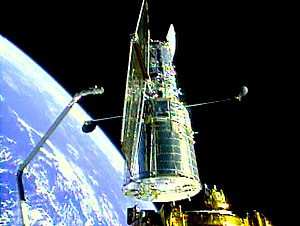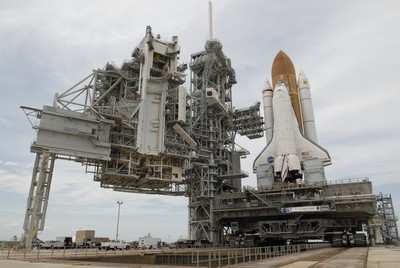Daunting Tasks Must Be Accomplished In VERY Hostile
Environment
 Astronauts preparing for the upcoming STS-125 mission to
service the Hubble Space Telescope -- the last such flight ever to
the orbital observatory -- have a daunting tasks ahead of them. Not
only will they be performing some of the most complex tasks ever in
the history of the shuttle program... but they'll be doing so in a
decidedly unwelcoming neighborhood.
Astronauts preparing for the upcoming STS-125 mission to
service the Hubble Space Telescope -- the last such flight ever to
the orbital observatory -- have a daunting tasks ahead of them. Not
only will they be performing some of the most complex tasks ever in
the history of the shuttle program... but they'll be doing so in a
decidedly unwelcoming neighborhood.
MSNBC reports astronauts working to repair, service, and replace
components on the 18-year-old Hubble will be using over 60 new
tools, specially created for the mission. "We had to develop a
whole new class of tools for spacewalking," said astronaut John
Grunsfeld, who will be making his third trip to the telescope
onboard the shuttle Atlantis next month.
Among the most vital is the new "Mini Power Tool," a
pistol-shaped combination screwdriver/drill that includes an LED
diode at the tip to illuminate the telescope's inner circuitry. The
tool will be used to swap out worn circuit boards inside the
telescope's Advanced Camera for Surveys and the Space Telescope
Imaging Spectrograph -- boards that "were basically never designed
to be accessed," in the words of STS-125 lead spacewalker officer
Tomas Gonzalez-Torres.
Accessing the spectrograph alone will require the removal of 117
tiny fasteners... and not losing them in zero-g, as just one loose
screw could damage the telescope's delicate optics. Aiding
spacewalkers' efforts will be specially-developed, color-coded,
see-through panels that resemble a toddler's "busy boards," but
will separate and capture the screws as they're removed. New,
snap-on panels will then replace the old covers.
Another new tool was also inspired by more Earth-bound needs:
the 'reach extender,' which resembles a commercial product called
the "PikStik" that you can find at nearly any Wal-Mart... or,
again, in a child's toolbox.
"That was the first thing that I had envisioned using on
Hubble," said rookie astronaut Drew Feustel, who developed an
industrial-strength version of the tool with Grunsfeld's help. It
will be used to push the telescope's new gyros into place.
For inspiration, both Feustel and Mini Power Tool chief engineer
Matt Ashmore drew on their experience tinkering with cars... and
then designed special, on-orbit versions of many of the same tools
found in a Snap-On toolbox. Feustel was once an automobile
mechanic, while Ashmore often spends weekends working on his
"baby," a 1969 Dodge Polara.
Of course, unlike the relative safety of a garage, STS-125
astronauts will be conducting their repairs in the hostile
environment of space... and the mission parameters mean that
astronauts will face a greater-than-usual risk of colliding with
space debris.
Due to the Hubble's higher orbit, the shuttle will be exposed to
far greater amounts of orbital debris than the low-Earth orbital
environment where the International Space Station is parked. Adding
to the danger is the recent destruction of a Chinese satellite, and
an old Russia rocket.
"We've had some vehicle breakups on orbit, and they have made
the (debris) environment worse," shuttle program manager John
Shannon told USA Today.
In fact, the risk to the repair mission exceeds NASA's own
safety parameters. "Normal" shuttle missions to the ISS carry a
one-in-300 risk of a catastrophic collision with space debris; the
Hubble flight will carry a one-in-185 risk, and will require NASA
Administrator Michael Griffin to give the official go-ahead before
Atlantis launches towards Hubble on October 10.

STS-125 commander Scott Altman says his crew knows the risks.
"That comes with the mission," he said. "Hubble is where it is...
We've got to go where the work is."
 ANN's Daily Aero-Term (04.24.24): Runway Lead-in Light System
ANN's Daily Aero-Term (04.24.24): Runway Lead-in Light System ANN's Daily Aero-Linx (04.24.24)
ANN's Daily Aero-Linx (04.24.24) Aero-FAQ: Dave Juwel's Aviation Marketing Stories -- ITBOA BNITBOB
Aero-FAQ: Dave Juwel's Aviation Marketing Stories -- ITBOA BNITBOB Classic Aero-TV: Best Seat in The House -- 'Inside' The AeroShell Aerobatic Team
Classic Aero-TV: Best Seat in The House -- 'Inside' The AeroShell Aerobatic Team Airborne Affordable Flyers 04.18.24: CarbonCub UL, Fisher, Affordable Flyer Expo
Airborne Affordable Flyers 04.18.24: CarbonCub UL, Fisher, Affordable Flyer Expo




